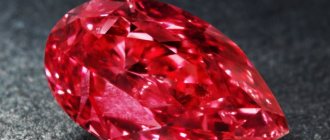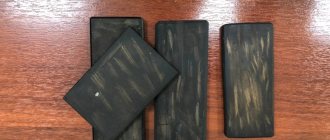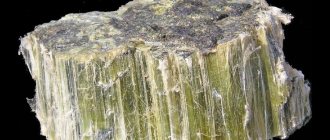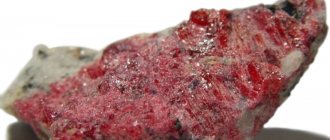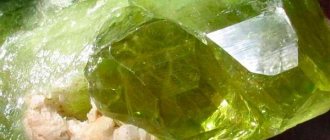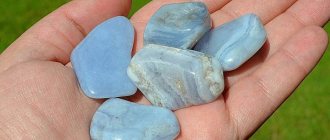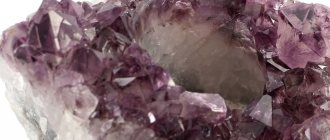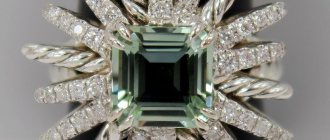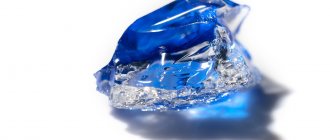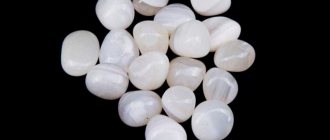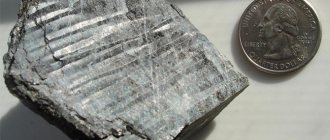From time to time, aliens from outer space come to us - these are meteorites, “pieces of unearthly matter” (literally - “stone from the sky”) that fell to the ground. In addition, from collisions with these “guests”, new minerals in composition can form on the surface of the earth under the influence of extreme temperatures. There is still no consensus among scientists about the origin of some “space” stones. Are they completely extraterrestrial, or are they terrestrial rocks that have been altered by a meteorite impact? Be that as it may, you will agree that it is very tempting to become the owner of a rare pebble - a fragment of a celestial body that flew to Earth from space.
Black diamonds came from space
Black diamonds (carbonados) are becoming an increasingly popular gemstone due to their origin. They were created in space! After many years of research, scientists confirmed using infrared instruments that they were formed due to a supernova explosion.
Unlike regular diamonds, black diamonds were not formed hundreds of kilometers below the Earth's surface, where the environment turns carbon into the diamonds that many of us wear as jewelry. Black diamonds are found only in certain parts of the world, including Africa and Brazil, and are thought to have arrived on Earth via meteorites.
Who is suitable according to their zodiac sign?
Now let's talk about the magical properties of a black diamond. Esotericists have long endowed this stone with incredible sacred power. According to them, black diamond:
- helps to accentuate leadership character traits,
- gives clarity of mind and firmness of judgment,
- helps in achieving goals and self-improvement,
- harmonizes relationships in couples,
- protects from negative energy,
- has healing and rejuvenating properties.
Ring with black diamonds in the Sunlight catalog
It is believed that black diamonds are endowed with powerful energy. An internally weak person can succumb to the influence of the stone, becoming angry, suspicious and self-centered.
Black diamonds are most suitable for Leo, Taurus and Libra. But Aquarius and Pisces are better off not wearing these delightful stones (at least not all the time).
Iron meteorites fell to Earth
The gems that fell to Earth have been the subject of fascination and perhaps even fear for many years by humanity, who did not understand how they got here. Of course, being not created on Earth, they are of great importance for science. The materials from which they are made are rare. Many meteorites that come from space are so small and attractive that they can be used in their original state. Take, for example, iron meteorites. They are created from iron and nickel alloys, making them ideal for jewelry.
The Explosive Growth of Suzhou City
Suzhou is located at the mouth of the Yangtze River.
Original photo: NASA/METI/AIST There is a 31 year difference between the photographs. Undeveloped plots of land in 1984 versus 2015 are marked in red. It is clear how much the previously relatively small settlement has grown.
The image area is 2,554 square kilometers.
A suburb of Suzhou with the Suzhou IFS skyscraper on the horizon. I took this photo in 2019 on the road from Shanghai to Nanjing
Suzhou on the world map and large-scale via a regular satellite
The city of Suzhou is more than 2500 years old, it is located in the eastern part of China - next to Shanghai. Thanks to reforms and the strengthening of the country's economy, the territory was actively populated, so that since the 1990s the population has grown from 900 thousand to 5.3 million.
In addition to tourism, investments are now flowing there in the fields of industry, logistics, science and finance.
Asteroid diamonds in Russia
Diamonds are formed under extreme temperatures and pressures deep in the earth's core. However, these same conditions can be found on the planet's surface during extreme events such as an asteroid impact.
In Russia there is a crater called Popigai, which was created as a result of an asteroid impact. Inside this crater lies the world's largest known diamond deposit. These Russian diamonds were formed when an asteroid hit the Earth. Unfortunately, these diamonds are not gem quality, so they cannot be used in jewelry, but they are used in industry.
Fakes
It is very easy to accidentally buy a fake black diamond because it is almost impossible to distinguish it from a real one at first glance. Counterfeits are made from ordinary diamonds by firing at high temperatures and irradiation. Sometimes simply low-quality crystals are used for these purposes.
You can distinguish a fake mineral through examination.
Typically it includes:
- examining the stone under a microscope (an artificially colored diamond is more spotted than a natural one);
- placing it under the bright light of a lamp, usually LED (the edge of the fake changes its tint to greenish or brownish);
- conductivity test.
Only if your purchase has successfully passed all these examinations can we say that this is an original.
Cosmic chrysolite
Peridot is one of the first gemstones and was called the stone of the sun by the ancient Egyptians, who found a deposit on an island in the Red Sea. Today it can be found in many other places, including the United States and Pakistan, where many of the best examples were found.
Just half a century ago, a huge meteorite was found in Argentina containing a huge amount of sought-after peridot crystals. Most of it was purchased by an American collector and divided up for sale. The elements can be found using special laser beams and spectrometry that check for the amount of lithium, vanadium, cobalt, manganese, nickel and zinc. This allows both researchers and buyers to learn more about the origins of gemstones.
A recent study found that pallasites were created by a collision between an asteroid and a planet-like body just 1/30 the size of Earth. This is believed to be what created the characteristic mixture of materials found in meteorites. The iron and nickel found in gemstones are believed to have come from an initial collision rather than from the same source. The molten iron that was at the center of the asteroid was ejected into the planet-like body, creating different textures.
"Stones of Heaven" from the Moon and Mars
Svetlana Ivanovna Demidova, Candidate of Geological and Mineralogical Sciences
“Chemistry and Life” No. 6, 2015
About classification
Rice. 1.
Fragments of meteorites in the rocky desert of Oman
One of the main sources of information about the composition of cosmic matter in the Solar System is meteorites. Among them are rare guests from the Moon and Mars. How they were discovered, how to recognize them, and much more will be discussed in this article.
First, let's recall a few basic concepts. Meteorites are made of iron, stony-iron and stone. Stony meteorites consist mainly of silicates (olivine and pyroxene) and, in turn, are divided into two subclasses: chondrites and achondrites. Chondrites get their name from the fact that they all (with rare exceptions) contain chondrules, spherical formations less than a millimeter in diameter, predominantly of silicate composition, formed as a result of short local heating of nebular gas and dust. Meteorites of this subclass formed in a protoplanetary cloud.
Achondrites do not contain chondrules and are igneous (igneous) rocks or breccias, clastic rocks resulting from crushing and mixing during impact processes. Achondrites formed not in a protoplanetary cloud, but in cosmic bodies. Due to melting, and on a planetary scale, and subsequent fractionation (separation) of melts and solid matter, achondrites somehow differ in composition from the original chondritic material. Therefore, according to the degree of differentiation of the substance of the mother cosmic body, primitive and differentiated achondrites are distinguished.
Differentiated ones, in particular, include lunar and Martian meteorites. It is the Martian ones that are also called SNC meteorites - after the Shergotty, Nakhla, Chassigny meteorites. Based on these meteorites, the corresponding subgroups were named - shergottites, naclites, chassignites. Each of the subgroups is characterized by its own rock types and compositions.
Rice. 2.
A little history
Evidence of falls of meteorite stones can be traced back to the 7th century BC. e., they are mentioned in the Bible, Chinese manuscripts, the works of Livy and Plutarch. In Russian chronicles, the fall of a meteorite was first noted in 1091: “...The great serpent fell from heaven, terrifying all people. At the same time I will knock on the earth, as if I heard many people...” (Laurentian Chronicle).
In ancient times, meteorites were attributed to divine origin and were the subject of veneration. Diogenes tried to explain their nature. Paracelsus expressed the opinion that meteorites are extraterrestrial objects. Italian astronomer Giovanni Battista Riccoli first spoke about the possibility of rocks falling to Earth from the Moon back in 1651. It is all the more surprising that during the period of rapid development of science in the 18th century, scientists came to the conclusion that it was impossible for meteorites to fall to Earth, which delayed the development of the science of meteorites. A turning point in the attitude of scientists towards meteorites came at the turn of the 18th–19th centuries, in particular, thanks to the work of the outstanding scientist, corresponding member of the St. Petersburg Academy of Sciences E. F. Chladni.
At the dawn of the formation of scientific meteoritics, it was assumed that all meteorites (then called aerolites) were of lunar origin. This hypothesis was later mathematically substantiated and widely propagated. In those years, newspapers published forecasts about the impending fall of stones from the Moon, and moon rocks were traded in Paris. Subsequent long-term studies showed that most meteorites arrive on Earth from the asteroid belt; the idea of meteorites from the Moon was forgotten for many years. The possibility of the existence of Martian meteorites was not even thought of at that time.
The triumphant space programs of the 20th century, the delivery of 382 kg of lunar samples to Earth during the Apollo and Luna missions in 1969–1976, made it possible to study them using all methods available at that time and create a solid knowledge base about the composition of the Moon. Despite this, the first lunar meteorite, Yamato 791197, discovered in November 1979 in the ice of Antarctica by the 20th Japanese Antarctic Expedition, could not be immediately identified due to its external similarity to some carbonaceous chondrites. It remained unstudied for a long time, so the first lunar meteorite is considered ALHA81005, found in 1982 there, in Antarctica. To date, more than 150 lunar meteorites with a total mass of more than 80 kg have been discovered on Earth. Their sources are approximately 70 different meteorite showers. Fragments of one meteorite shower, that is, paired finds, are considered to be meteorites found nearby, having a similar composition and the same earthly age.
Around the same time, Martian meteorites were identified. Unlike the lunar ones, there was nothing to compare them with, and the assumption about their Martian nature was made on the basis of several indirect signs. The first clue arose when an unusual group of meteorites with a young crystallization age by “meteorite” standards was revealed (it is determined by isotope geochronology methods). Indeed, the age of most meteorites, both chondrites and achondrites, is about 4.5 billion years, while SNC meteorites are much younger - mostly less than 1 billion years. In addition, they turned out to be richer in volatile elements (eg, nitrogen, noble gases) compared to other achondrites. Based on these observations, the idea arose that the source of SNC meteorites should be a large planetary body comparable in size to the Earth, that is, capable of retaining volatile elements and remaining geologically active for a long time after formation.
The best candidate for this role was Mars - its size is large enough, and it has a tenuous atmosphere that does not prevent the ejection of material from the surface into space as much as the atmosphere of Venus could. In addition, it could be assumed that on Mars, given its size, there are enough radioactive heat-generating elements to ensure prolonged geological activity. What finally confirmed scientists in the opinion that SNC meteorites are aliens from Mars was the study of Donald Bogard and Pratt Johnson, who in 1983 studied gas bubbles in some shergottites. They showed that the ratios of the abundances of noble gases and their isotopic composition corresponded to those in the Martian atmosphere studied by the Viking spacecraft. To date, about 70 Martian meteorites have been discovered; some of them may be fragments of the same meteor shower.
Are you from the Moon or Mars?
To distinguish between lunar and Martian meteorites, let's look at their parents. The Moon has no atmosphere, and on its surface there is a loose layer of debris up to 10 m thick - regolith. It was formed due to the crushing and mixing of bedrock material during meteorite bombardment of the lunar surface. The bedrock of the Moon is divided into two groups - continental (these are mainly anorthosites, consisting of feldspar), and marine (basalts). Marine, of course, have nothing to do with water seas - dark areas of the surface are called seas. Continental rocks are very ancient, up to 4.5 billion years old, which is close to the time of formation of planetary bodies. They were formed mainly during a period of intense meteorite bombardment more than 3.9 billion years ago. Therefore, the continental rocks of the Moon are mainly breccias, clastic rocks. At the end of this period, eruptions of marine basalts occurred, mainly 3.8–3.2 billion years ago. Lunar seas occupy 17% of its surface, approximately the same proportion of marine meteorites. In general, the population of lunar meteorites corresponds to the composition of the lunar surface; continental meteorites predominate among them, with fewer marine ones and quite a lot of mixed ones.
Rice. 3.
Fragment of a thin section of the lunar meteorite Dhofar 311 (transmitted light). A typical lunar continental breccia in which rock and mineral fragments are embedded in a glassy groundmass of impact melt
Most continental and mixed meteorites, of course, are breccias—rocks containing rock and mineral fragments in a glass-like matrix formed by impact and melting. Among marine meteorites there are both ordinary basalts and basaltic breccias. They became breccias because meteorite bombardment continues to this day, only its scale has decreased, and the regolith formed in the sea area is less powerful than in the continental area.
Now about the other parent - Mars. Its surface is also covered with a cover of regolith, but not as thick as on the Moon. On Mars, its formation was facilitated not only by meteorite bombardment, but also by weathering. Mars once had a fairly dense atmosphere, which provided a relatively warm climate and the presence of liquid water on the surface. This is evidenced by the presence of perhaps the most impressive Martian landforms, the so-called outflow valleys - dry channels reminiscent of the Earth's river network. Then the atmosphere became increasingly rarefied, which gradually led to complete desertification. All this was accompanied by periods of volcanic activity; its products on the surface of Mars are basalt sheets and shield volcanoes. As on Earth, sediment accumulation processes played an important role on Mars.
All SNC meteorites are igneous rocks of basic and ultrabasic composition (main minerals: pyroxene, olivine, plagioclase), which were formed during the crystallization of basaltic magmas. It is interesting that, despite the large number of impact craters on the surface of Mars, of the 70 known Martian meteorites, only one meteorite, NWA 7034, is represented by impact breccia, although all SNC meteorites bear signs of impact. In addition, among them there is not a single sample of sedimentary rocks from Mars similar to those found by the Opportunity and Curiosity spacecraft. Either this is due to the lack of representativeness of the sample of Martian meteorites, or to the low strength of such rocks; moreover, there is a high probability of confusing them with terrestrial sedimentary rocks. But in any case, new finds of Martian meteorites may bring surprises.
Achondritis came to the researcher
Where is he from? From the moon? From Mars? Or from somewhere else?
If the meteorite is brecciated and contains more than 50% plagioclase, and calcium plagioclase (anorthite), then most likely it is a lunar continental meteorite, which can be confirmed by additional criteria. If the plagioclase content is less than 50%, there are options: it could be a lunar marine meteorite, or a Martian meteorite, or a meteorite of the Howardite, Eucrite, Diogenite (HED) group, the source of which is considered to be the Vesta asteroid.
Another identifying feature of lunar and Martian meteorites is the Fe/Mn ratio in the main rock-forming minerals olivine and pyroxene. For lunar rocks in olivines it is approximately 89, and in pyroxenes it is 54. For Martian rocks it is approximately 43 and 30, respectively.
Another criterion, universal not only for lunar, Martian, but also for all meteorites, is the isotopic composition of oxygen. It reflects the primary characteristics of matter and has specific features in different cosmic bodies. Unlike Martian meteorites with their unique oxygen isotope composition, lunar rocks are indistinguishable from terrestrial ones in this regard.
But it is impossible to confuse lunar matter with terrestrial matter because of its mineral composition. As noted earlier, the main mineral of continental rocks, plagioclase, which has the composition of anorthite, is rarely found on Earth. In terrestrial rocks, as well as in Martian rocks, plagioclase contains more alkaline elements. There are also differences in the chemical composition of other rock-forming minerals - olivines and pyroxenes. Typically lunar accessory minerals - armolcolite, tranquillithiite, pyroxferroite - were first discovered in lunar samples and only later in terrestrial rocks, where they are extremely rare, and are not found at all in Martian rocks. In the latter, in turn, you can find magnetite, which you will not see in lunar rocks. This is explained by significant differences in redox conditions on the Moon and Mars. Therefore, in particular, Fe,Ni metal, a natural alloy of Fe and Ni, is absent in SNC meteorites, but it is usually present in lunar matter. Another consequence is the anomalous behavior of europium during the formation of lunar rocks. In the oxidizing conditions of the Earth and Mars, Eu, like other rare earth elements, exhibits a valence of +3 and is not separated from them, while in the reducing conditions of the Moon, europium is divalent and is concentrated in plagioclase, replacing calcium in it.
The most important feature of lunar rocks is the absence of water and other highly volatile compounds in them, therefore there are no water-containing minerals on the Moon, which significantly impoverishes the diversity of mineral species. Although it is now believed that small quantities of water in the form of ice may be found in the area of the lunar poles. The presence of water on Mars, albeit in the past, led to the formation of secondary clay minerals and carbonates, which are rare but found in all SNC meteorites, especially in naclites and ALH84001. It was in the latter that carbonate formations with inclusions of hydrocarbons and magnetite of a specific morphology were discovered, which, due to the assumption of their biogenic origin, brought him world fame (see “Chemistry and Life”, 1997, No. 3, “Is there any benefit from life on Mars "). However, most scientists now adhere to the abiogenic hypothesis of their formation.
Unfortunately, many desert finds have similar secondary mineralization, that is, they contain carbonates and clay minerals, but of terrestrial origin, and additional labor-intensive research is needed to distinguish one from the other. Fortunately, some Martian meteorites, such as Chassigny, Shergotty, Nakhla, Tissint and Zagami, are fresh falls collected immediately after landing, and Antarctic finds also do not bear traces of being on Earth. As for the circumstances of the fall of lunar meteorites, no one has ever seen them. Surprisingly, all 180 lunar meteorites are finds, that is, meteorites that no one observed falling.
What finally convinces the researcher of the origin of the meteorite is its age. Lunar meteorites are much older than Martian meteorites. The exception is the unique meteorite ALH 84001 (4.5 billion years), all other Martian samples are significantly younger than -0.1–1.4 billion years.
And lastly: of course, determining all these parameters requires serious research using modern technology, but it is often enough for a specialist to look through a microscope to determine the source of the meteorite.
Where they search and find
Meteorites have fallen always and everywhere, but it is difficult to detect them in mountains or forests, except in cases where the fall or scattering of meteorite shower fragments is observed and the search area can be specified. However, there are places on Earth where meteorites are easier to find. Meteorites began to be found in Antarctica from the very beginning of the study of this continent. The first meteorite was found in 1912, several more in the 1960s, but a turning point occurred in 1969, when Japanese scientists discovered nine meteorites in an area of 3 km2. The most surprising thing was that these meteorites represented five different types. Successful Japanese and American Antarctic expeditions to collect meteorite material followed, resulting in more than 40,000 samples.
What is the reason for such wealth in Antarctica? First of all, dark meteorites are clearly visible on a white surface, and the cold, dry climate allows them to be well preserved. In addition, they can be concentrated in some places. Meteorites fall to the surface and over time become buried in a thick layer of snow and ice. If a glacier begins to move towards the edge of the continent into a warmer area and encounters an obstacle on its way that impedes its further progress, for example a mountain range, then, having stopped, the ice sublimates and meteorites remain on the surface of the glacier, which can be collected.
Another good place to collect meteorites is deserts. The idea of searching for meteorites in the desert was first expressed by Antoine de Saint-Exupery in the story “Planet of People”: “Only an apple can fall on a tablecloth spread under an apple tree, only star dust can fall on a tablecloth spread under the stars, never one.” the meteorite did not show so clearly where it came from.” Simultaneously with the finds in Antarctica, meteorites were discovered in the deserts of Australia, where a systematic search for them has been carried out since 1971. Since 1986, meteorites began to be successfully collected in the Sahara, and since 1999, in the deserts of the Arabian Peninsula. Favorite search places are rocky deserts, their surface remains unchanged for a long time, and the dry climate contributes to the preservation of meteorites. If there is water, it penetrates through cracks, and due to the Rebinder effect (propping action) it can destroy the meteorite; in addition, more fragile secondary minerals are formed, that is, over time, meteorites crumble, just like terrestrial rocks. In dry climates, meteorites survive better and accumulate. Today, about 15,000 meteorites have been collected in deserts, and their number is growing. Usually the search is carried out by so-called meteorite hunters, members of special expeditions or enthusiasts, or local residents.
Meteorites are named according to their location. For example, meteorites called Yamato were collected in Antarctica near the mountain range of the same name, meteorites NWA (North West Africa) - in the Western Sahara region. All Antarctic and most desert finds do not have exact coordinates of the place of discovery, which is a pity: many meteorites fall in the form of meteorite showers, and determining pairing (that is, belonging to the same meteorite shower) is not an easy task.
In conclusion, let us cite the words of the German philosopher Johann Gottlieb Fichte: “Nothing true and useful, once it has become the property of mankind, will be wasted, even if only distant posterity learns to use it.” Meteorites have been and remain a source of unique knowledge and new unexpected discoveries, and we are lucky that we live on Earth, because the inhabitants of the Moon and Mars have practically no chance of finding meteorites from Earth.
What else can you read about meteorites:
Website of the Laboratory of Meteoritics GEOKHI RAS (a lot of useful information, as well as recommendations for those who found a meteorite or observed its fall). Lunar meteorites. Martian meteorites.
Moldavite
Moldavite is an olive-green stone formed as a result of an asteroid impact with the Earth 15 million years ago. The speed and high temperature allowed the stone to collapse and spread throughout Austria, Germany and the Czech Republic. High-quality moldavite is most often sold as a jewelry gemstone. Collectors usually buy uncut stones. This is a fragile gemstone that is best used in earrings or other jewelry that is not subject to heavy wear.
Libyan glass
Libyan glass is found in the Libyan Desert and dates back to 26 million years ago. There are many theories about how this glass formed, but the most common theory is that a meteorite was responsible for suddenly melting material on the desert surface and creating the glass. It was a process similar to glass making.
There is still a lot of material for scientific work on the topic of precious stones from space. There may be no scientific evidence that these stones can help heal ailments, but they are beautiful and sought after, ideal for many types of jewelry and designs.
For more information, visit https://www.gemrockauctions.com/learn/did-you-know/space-stones-gems-that-originated-in-outer-space
Price
One pure black diamond (refined) weighing two carats (how carats are measured in diamonds →) can cost more than half a million rubles or more. However, there are buyers for both the 2-carat mineral and those that weigh more. But still this price is not as high as that of a red diamond.
Carbonados of lower cost and with more inclusions are common in non-luxury products. There are also minerals that have a rather grayish color and a porous structure. But they all bear the name black. Table for determining the quality of diamonds by clarity →
The complexity of its processing also adds to the price of this “guest from outer space”. Up to two-thirds of the material is lost during cutting. This happens because it has a very high strength coefficient. It is not amenable to all tools, and even with highly professional processing using the latest technologies, a significant part of the mineral is simply lost - after all, black diamond chips are not valued as highly as white ones.
